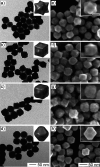Deterministic Synthesis of Pd Nanocrystals Enclosed by High-Index Facets and Their Enhanced Activity toward Formic Acid Oxidation
- PMID: 37654808
- PMCID: PMC10467563
- DOI: 10.1021/prechem.3c00060
Deterministic Synthesis of Pd Nanocrystals Enclosed by High-Index Facets and Their Enhanced Activity toward Formic Acid Oxidation
Abstract
Noble-metal nanocrystals enclosed by high-index facets are of growing interest due to their enhanced catalytic performance in a variety of reactions. Herein, we report the deterministic synthesis of Pd nanocrystals encased by high-index facets by controlling the rate of deposition (Vdeposition) relative to that of surface diffusion (Vdiffusion). For octahedral seeds with truncated corners, a reduction rate (and thus deposition rate) faster than that of surface diffusion (i.e., Vdeposition/Vdiffusion > 1) led to the formation of concave trisoctahedra (TOH) with high-index facets. When the reduction was slowed down, in contrast, surface diffusion dominated the growth pathway. In the case of Vdeposition/Vdiffusion ≈ 1, truncated octahedra with enlarged sizes were produced. When the reduction rate was between these two extremes, we obtained concave tetrahexahedra (THH) without or with truncation. Similar growth patterns were also observed for the cuboctahedral seeds. When the Pd octahedra, concave TOH, and concave THH were tested for electrocatalyzing the formic acid oxidation (FAO) reaction, those with high-index facets were advantageous over the conventional Pd octahedra enclosed by {111} facets. This work not only contributes to the understanding of surface diffusion and its role in nanocrystal growth but also offers a general protocol for the synthesis of nanocrystals enclosed by high-index facets.
© 2023 The Authors. Co-published by University of Science and Technology of China and American Chemical Society.
Conflict of interest statement
The authors declare no competing financial interest.
Figures






Similar articles
-
Prescription of Controlled Substances: Benefits and Risks.2025 Jul 6. In: StatPearls [Internet]. Treasure Island (FL): StatPearls Publishing; 2025 Jan–. 2025 Jul 6. In: StatPearls [Internet]. Treasure Island (FL): StatPearls Publishing; 2025 Jan–. PMID: 30726003 Free Books & Documents.
-
Sexual Harassment and Prevention Training.2024 Mar 29. In: StatPearls [Internet]. Treasure Island (FL): StatPearls Publishing; 2025 Jan–. 2024 Mar 29. In: StatPearls [Internet]. Treasure Island (FL): StatPearls Publishing; 2025 Jan–. PMID: 36508513 Free Books & Documents.
-
Surveillance for Violent Deaths - National Violent Death Reporting System, 50 States, the District of Columbia, and Puerto Rico, 2022.MMWR Surveill Summ. 2025 Jun 12;74(5):1-42. doi: 10.15585/mmwr.ss7405a1. MMWR Surveill Summ. 2025. PMID: 40493548 Free PMC article.
-
Intravenous magnesium sulphate and sotalol for prevention of atrial fibrillation after coronary artery bypass surgery: a systematic review and economic evaluation.Health Technol Assess. 2008 Jun;12(28):iii-iv, ix-95. doi: 10.3310/hta12280. Health Technol Assess. 2008. PMID: 18547499
-
Systemic pharmacological treatments for chronic plaque psoriasis: a network meta-analysis.Cochrane Database Syst Rev. 2017 Dec 22;12(12):CD011535. doi: 10.1002/14651858.CD011535.pub2. Cochrane Database Syst Rev. 2017. Update in: Cochrane Database Syst Rev. 2020 Jan 9;1:CD011535. doi: 10.1002/14651858.CD011535.pub3. PMID: 29271481 Free PMC article. Updated.
References
-
- Wang T., Chutia A., Brett D. J. L., Shearing P. R., He G., Chai G., Parkin I. P.. Palladium Alloys Used as Electrocatalysts for the Oxygen Reduction Reaction. Energy Environ. Sci. 2021;14:2639–2669. doi: 10.1039/D0EE03915B. - DOI
-
- Pàmies O., Margalef J., Cañellas S., James J., Judge E., Guiry P. J., Moberg C., Bäckvall J.-E., Pfaltz A., Pericàs M. A., Diéguez M.. Recent Advances in Enantioselective Pd-Catalyzed Allylic Substitution: From Design to Applications. Chem. Rev. 2021;121:4373–4505. doi: 10.1021/acs.chemrev.0c00736. - DOI - PMC - PubMed
LinkOut - more resources
Full Text Sources
